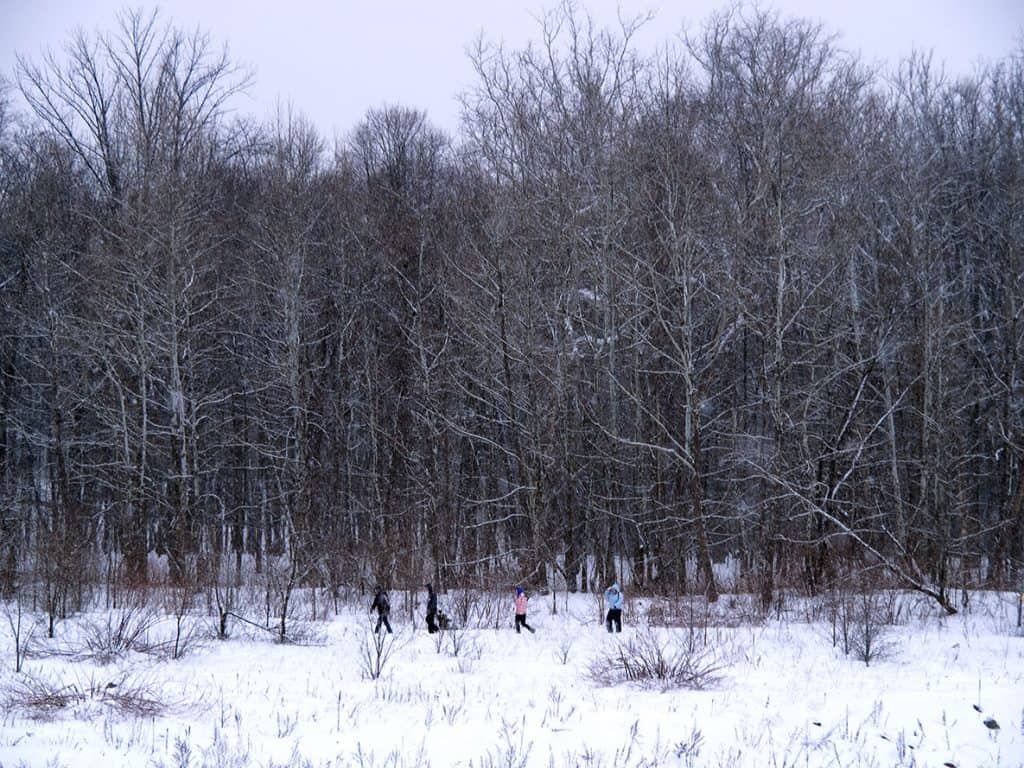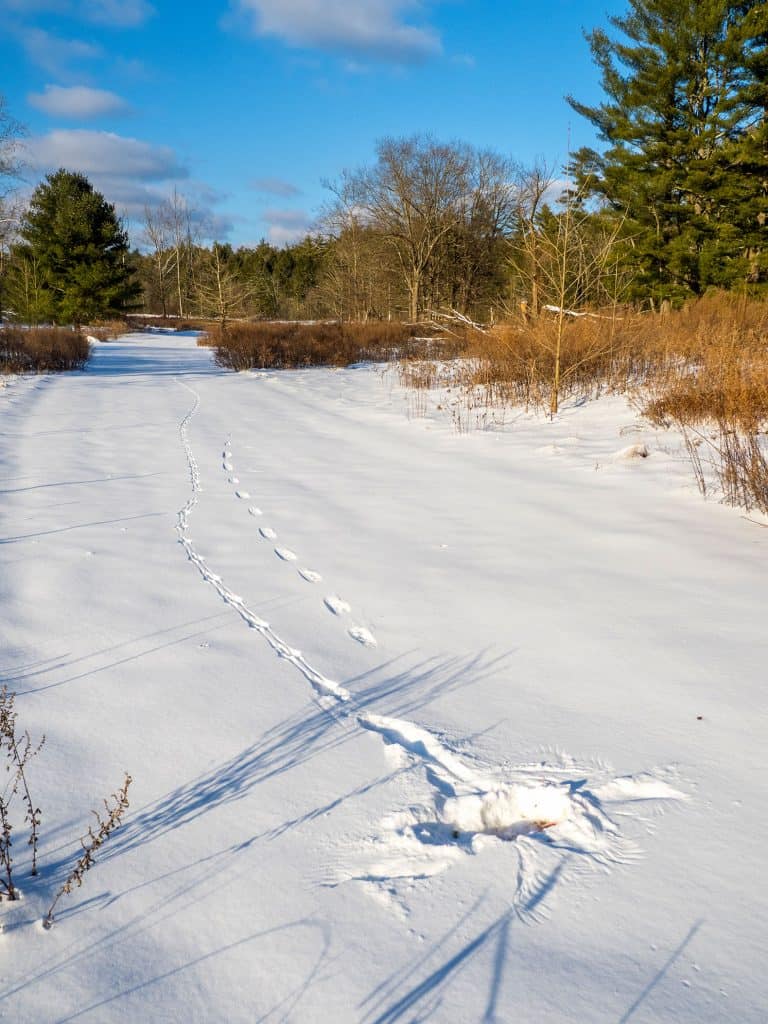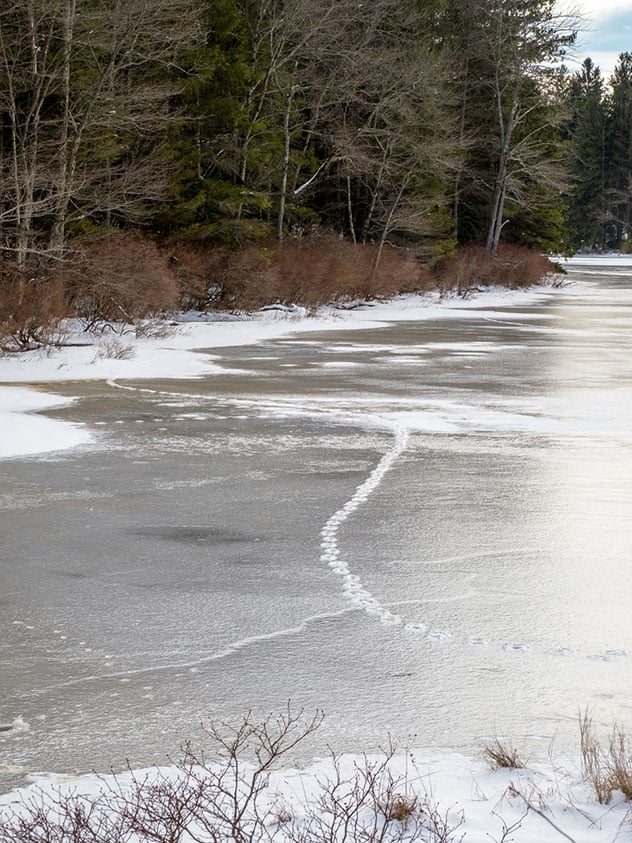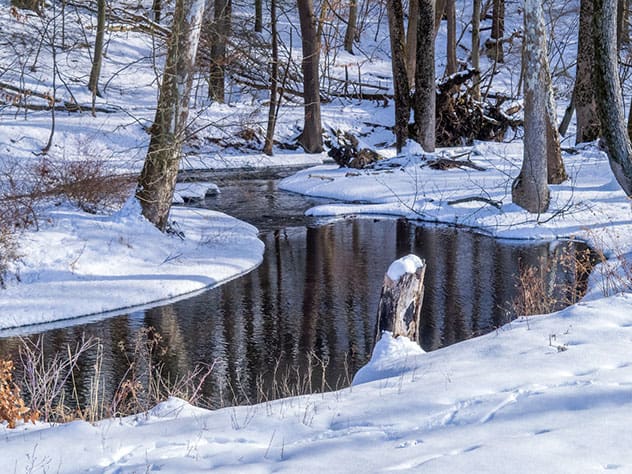
WOODS & WATER: SNOW STORIES
Snow tells tales of life, death and our changing climate

By Carol Hillestad
Editor’s note: “Woods & Water” is a new occasional feature focusing on the relation between land and water quality – and the conservation easements that help preserve our environment in the Brodhead watershed.
By Carol Hillestad
For Brodhead Watershed Association
“I can see my breath!” the little girl shouts before she hurtles down the sledding hill at Skywood Park in Paradise Township.
That cloud of mist is the warm air from her lungs, saturated with water vapor, condensing in the cold winter air. Warm air holds lots more moisture than cold air does. Air that’s warmer by just two degrees can hold 7% more moisture.
On a sledding hill, that doesn’t matter much. It does matter when a storm forms over the ocean off New Jersey and Long Island — where our nor’easters organize themselves and where surface temperatures are running up to three degrees above average. Warm surface air guzzles that moisture, turns it into snow, and next thing you know, you’ve got a lot of shoveling to do.
In the forest, it’s the same story. Fueled by warmer air, this year’s heavier-than-normal storms have filled the woods with a nourishing blanket of snow. In forestland, though, snow pack is a blessing.
That’s because when trees are dormant, they don’t draw up the 100 gallons of water a day an old tree uses in summer to make leaves, catkins, acorns, or beechnuts. The snow pack also insulates the forest floor and keeps it from freezing hard. So on sunny days that are even a few degrees above freezing, the cushiony forest floor keeps snowmelt from running off, allowing it to seep into pore spaces and cracks in rock, infiltrating dozens and hundreds of feet underground, replenishing groundwater.
Just one acre of forest with a 10-inch snowpack can hold 30,000 gallons of water or more.
That precious, naturally filtered and purified groundwater — millions of gallons in the Brodhead watershed — explains why our creeks and streams continue to flow, even in long dry stretches of summer. It keeps wells producing, and provides water for businesses, for tourism, industry and agriculture, and drinking water for millions of Pennsylvania residents.
In fact, in an average year, 10% to 25% of the water that flows in streams and fills groundwater wells originates from melting snow.
For people who take the time to look, snow is also an open stage. Not just to showcase peace and beauty — or even for snowshoeing, snow hiking, snowball fights, and snow angels.
Its smooth surface tells stories. Where deer spent the night. Where voles and other under-snow creatures moved in safety from place to place. Where turkeys scratched up acorns and beechnuts. And where a few drops of blood and a surface ruffled by wingbeats speak of a rabbit that met its fate in the steely talons of a silent owl.
Our Pocono forests are many things — cool respite on a summer day, reservoir for snowmelt, window on the natural world, protector of creeks and drinking water, legacy for a little girl’s future. As the lowering sun colors the snow violet, this protected forestland seems full of not just snow, but also hope. The little girl and I head home, thinking of dry socks and cocoa.
Carol Hillestad is a hike leader and writer for Get Outdoors Poconos, a grant-funded series administered by Brodhead Watershed Association. The series is administered by Brodhead Watershed Association and supported by a grant from the William Penn Foundation.

Drama in the snow at ForEvergreen Nature Preserve, Stroud Township: A rabbit’s trail ends when a large bird, probably an owl, swoops from above. Carrying off its prey, the bird takes more than 10 tries to become airborne. (Dave Trainer photo)
ABOUT SKYWOOD PARK
Skywood Park, on Route 191 in Paradise Township between Routes 940 and 390, is a popular sledding spot in winter. The park, open dawn to dusk, has picnic tables, benches and views toward Delaware Water Gap. Skywood is at the heart of about 1,500 acres of forested land parcels owned and protected by three groups: Pocono Area Recreation Commission (https://www.paradisetownship.com/pocono-area-recreation-commission), Pocono Heritage Land Trust (www.phlt.org), and Paradise Township (paradisetownship.com). The people of the township enacted a tax in the 1990s to preserve open space land for public enjoyment, wildlife habitat, and clean drinking water.
CLIMATE CHANGE: How warmer air and ocean surfaces affect wildfires, hurricanes, and storms
Seventy percent of Earth’s surface is ocean. In combination with our atmosphere, oceans are the engine of weather.
Heavier-than-usual rainstorms and snow events are one effect that warmer oceans have on humans, but there are many others, such as more (and more destructive) hurricanes. Because warm air is thirsty air, it pulls moisture from wherever it can — over water, but also over land including dead trees, the understory, shrubs and grasses, even the soil itself. That creates ultra-dry tinder and wildfires of epic proportions.
Humans survive naturally in a narrow range of balanced environmental factors. Protecting that balance is where our future lies.
For science-based information on climate, visit www.noaa.gov.
For information on oceans and climate: oceanexplorer.noaa.gov/facts/climate.html.

Half-frozen water bears the weight of small mammals. (Dave Trainer photo)

Deer tracks along a Pocono creek. (Dave Trainer photo)
Comments from other hikers:
Be the first to add your comment for this hike.